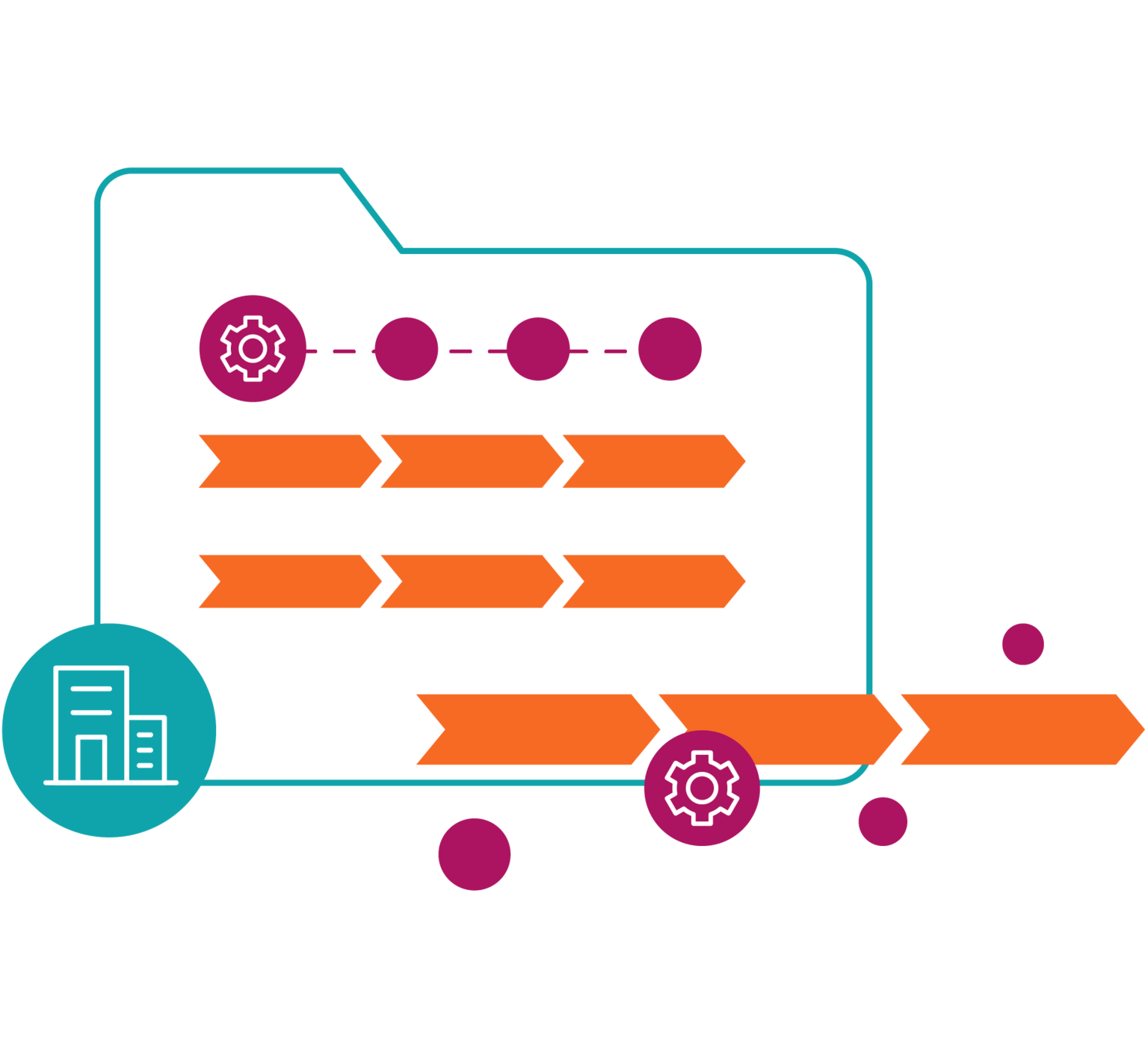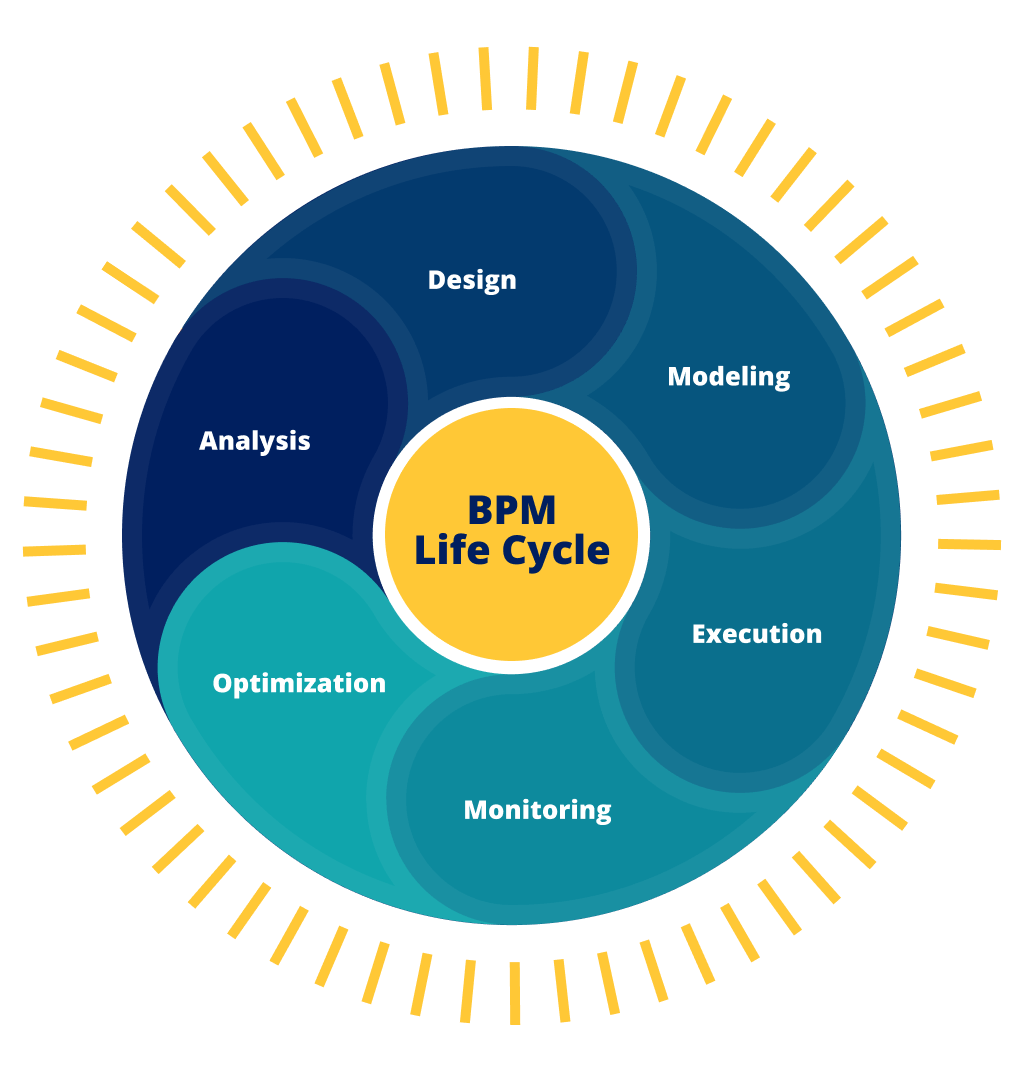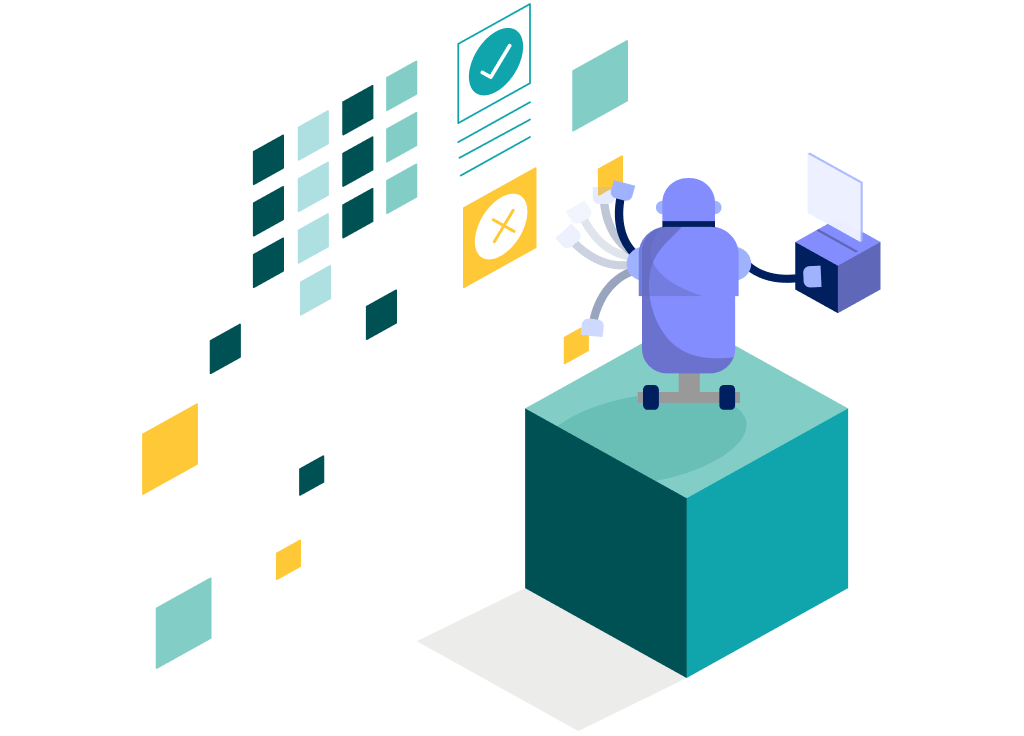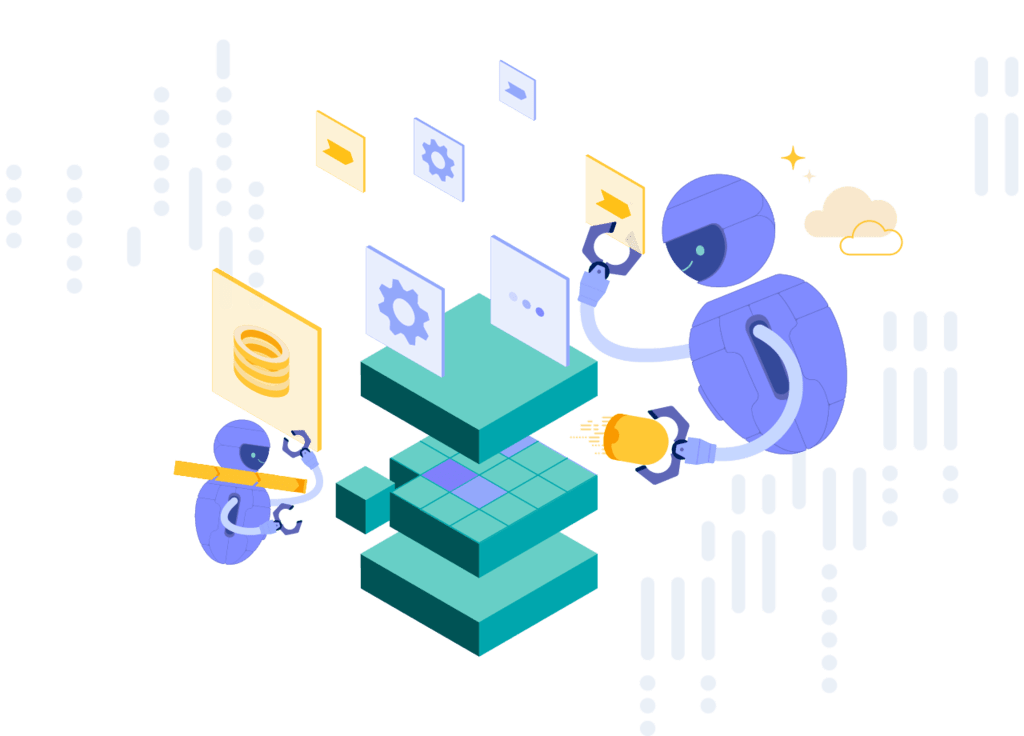Gestion des processus métier (BPM)
Qu’est-ce que le BPM ?
La gestion des processus métier (BPM pour « Business process management ») est une méthodologie permettant de gérer les processus et les workflows au sein d’une organisation. La gestion des processus métier vise à accroître l’efficacité, la performance et l’agilité des activités quotidiennes de l’entreprise. Largement adopté par les entreprises, le BPM est indispensable pour n’importe quelle entreprise qui souhaite être compétitive sur le marché d’aujourd’hui.
Regardez cette vidéo pour en savoir plus sur la solution de case management de Pega, notamment comment elle peut donner à votre organisation les moyens de gérer efficacement des processus métier complexes.
Pourquoi le BPM est-il important ?
Le Business Process Management vous aide à simplifier et à automatiser vos opérations, contribuant ainsi à réduire vos coûts et à améliorer votre agilité métier. En ayant recours au BPM, les organisations parviennent à produire des solutions reproductibles qui peuvent être réutilisées et personnalisées efficacement pour répondre aux exigences de divers utilisateurs, gammes de produits, canaux et zones géographiques.
Avantages du BPM
La gestion des process métier apporte des gains d’efficacité de plusieurs manières :
- Réduction des coûts et agilité opérationnelle : le BPM simplifie et automatise les opérations, ouvrant ainsi la voie à de fortes baisses des coûts.
- Solutions reproductibles : le BPM permet de créer des solutions efficaces, évolutives et adaptables.
- Workflows rationalisés : le BPM identifie et optimise les processus, en réduisant les redondances et en supprimant les points bloquants.
- Expérience utilisateur améliorée : le BPM limite les tâches fastidieuses et améliore la précision, ce qui se traduit par un nombre réduit d’erreurs et une meilleure expérience globale pour les clients et les employés.
- Prestation de services structurée : en créant un environnement structuré, le BPM réduit les temps de réponse et accélère le service client.
Il ne s’agit pas seulement d’améliorations opérationnelles. Le BPM dessine un paysage organisationnel réactif, rentable et convivial pour les utilisateurs. En intégrant le BPM, vous serez en mesure de vous imposer sur un marché en constante évolution.

Comment fonctionne le BPM ?
Le Business Process Management s’appuie sur une combinaison de technologies, comprenant notamment l’automatisation des workflows, l’aide à la décision basée sur l’IA et le case management, afin de développer des solutions complètes pour les organisations. En exploitant ces technologies, les organisations améliorent les processus métier et peuvent ainsi accélérer le Time-to-Market ; fabriquer, commercialiser et vendre les produits de façon plus rentable ; et enfin proposer un service client de qualité supérieure.


Lien entre BPM et automatisation
La gestion des processus métier (BPM pour « business process Management ») et l’automatisation des processus métier (BPA pour « business process automation ») fonctionnent en symbiose au cœur des organisations efficaces. La synergie dynamique entre ces deux approches permet de rationaliser les opérations, de réduire les erreurs et d’améliorer les performances globales de l’entreprise. Passons en revue les différences entre BPM et BPA :
BPM
- Stratégie globale
- Définit, modélise et optimise les processus métier
- Identifie les parties d’un workflow susceptibles de bénéficier d’une automatisation
BPA
- « Bras droit » du BPM
- Exploite la technologie pour automatiser les processus
- Actualise les améliorations identifiées en BPM
- Veille à ce que les tâches courantes et à base de règles soient exécutées de manière transparente, libérant ainsi des ressources humaines pour des activités plus stratégiques, créatives et complexes
Cas d’usage du BPM
Découvrez comment les entreprises de divers secteurs utilisent le BPM pour transformer leur façon de travailler.
Services financiers
La banque Banco Santander Basil s’appuie sur le BPM pour améliorer considérablement son service client. L’adoption des méthodologies BPM a permis à la banque d’optimiser ses processus de prestation de services, avec à la clé des délais de réponse réduits, un minimum d’erreurs et une satisfaction client accrue.
Santé
Highmark Health s’appuie sur le BPM pour créer des solutions innovantes et centrées sur le patient, illustrant les multiples avantages du BPM. Le focus sur l’optimisation des processus a permis à Highmark Health d’améliorer la qualité de service et de simplifier les tâches administratives, afin d’offrir de meilleurs soins à ses patients.
Tourisme et hôtellerie
Les fonctionnalités BPM permettent à Booking.com de gérer efficacement de nombreux types d’interactions avec les voyageurs et de rationaliser les processus de son service client. Cette approche garantit une plateforme robuste où les réservations, les demandes et les interactions client sont gérées de manière rapide et fluide.
Différents types de BPM
Il n’y a pas qu’une sorte de solution BPM. La gestion des processus métier a évolué pour répondre aux divers objectifs et défis organisationnels.
BPM centré sur l’intégration
Le BPM centré sur l’intégration cible les processus caractérisés par une implication humaine minime. Il s’appuie sur des API pour garantir une intégration efficace des données, à l’instar de qui est fait dans les systèmes de gestion des ressources humaines (HRM) ou de gestion de la relation client (CRM).
BPM centré sur l’humain
Le BPM centré sur l’humain est axé sur les processus nécessitant des interactions et des validations humaines. Il propose des interfaces intuitives pour l’attribution des tâches et la définition des responsabilités.
BPM centré sur les documents
Le BPM centré sur les documents concerne les processus de documentation. De la création à la validation, en passant par la revue et le stockage, le BPM rationalise tout ce qui concerne les documents essentiels à l’entreprise. Des tâches telles que la formalisation de contrats complexes ou la protection de la confidentialité des données sont ainsi facilitées.

Comprendre le cycle de vie BPM
Pour une mise en œuvre efficace du BPM, il est essentiel de comprendre son cycle de vie : une approche structurée qui guide la manière d’identifier, de concevoir, d’exécuter et d’améliorer les processus au fil du temps. Chaque phase joue un rôle essentiel dans la mise en place d'opérations métier efficaces, évolutives et adaptables.
- Analyse : découvrez et identifiez les processus et les workflows qui peuvent être créés ou optimisés afin de répondre aux exigences métier ou d’améliorer les performances.
- Conception : concevez des processus qui incluent des interactions entre humains, entre systèmes ou entre des humains et des systèmes. Cette conception vise à réduire les erreurs et à assurer le respect des procédures opérationnelles ou des SLA.
- Modélisation : utilisez des outils logiciels pour modéliser et évaluer les conceptions de processus de manière efficace. Une fois qu’une conception de processus est prête, faites varier les valeurs d’entrée pour observer son comportement. Si la conception n’aboutit pas au comportement souhaité, il est possible d’implémenter des modifications de manière itérative.
- Exécution : automatisez les processus avec les règles métier, l’aide à la décision, le case management et d’autres technologies associées.
- Surveillance : exploitez les données de reporting collectées à partir des processus, pour surveiller les performances, les erreurs et la conformité. La surveillance permet aux entreprises d’évaluer les solutions BPM déployées en se référant aux modèles de conception correspondants et aux KPI pertinents.
- Optimisation : exploitez les données issues des phases de modélisation et de surveillance pour identifier des axes d’amélioration en vue de tirer davantage d’efficacité et de valeur.
Composants du BPM
Principaux composants du BPM permettant des opérations plus intelligentes, rapides et cohérentes.Elle exploite les données, analyse les besoins immédiats et fournit la réponse adaptée à un instant T, pour convertir l’information en action.
Elle s’appuie sur l’IA pour prédire les besoins des clients, personnaliser les interactions et rationaliser les expériences sur l’ensemble des canaux.
Il gère le travail complexe des humains et des machines du début à la fin, avec un « dossier » au cœur de la gestion des tâches et des résultats.
Elles automatisent les processus complexes. La définition de règles permet d’atteindre des objectifs au sein d’une application métier.
Il fournit des statistiques que vous pouvez analyser pour produire des rapports simples à comprendre, en vue d’améliorer vos activités.
Elle fournit un framework de protection contre tout accès non autorisé. Elle empêche les attaques qui pourraient compromettre les performances et la disponibilité de vos services.
Elle permet d’accéder aux données de n’importe quelle application, grâce à des connecteurs, des adaptateurs et des services d’API étendus et flexibles.

Défis du BPM et solutions stratégiques
La mise en œuvre des systèmes BPM modernes continue de poser certains défis, mais il existe des solutions de plus en plus sophistiquées et stratégiques.
- La complexité de mise en œuvre peut constituer un obstacle à la gestion des processus métier. Un déploiement progressif, en commençant par quelques projets pilotes, peut aider les équipes à prendre confiance, à démontrer la valeur ajoutée et à réduire les risques, avant d’étendre à l'ensemble de l'organisation.
- La conduite du changement peut représenter un défi majeur, car les employés sont souvent réticents à adopter de nouveaux processus. Le succès nécessite une communication claire, une formation solide et des équipes transversales qui veillent à l'adoption et à l’ergonomie.
- L'intégration des technologies peut s'avérer complexe, mais elle est facilitée par des plateformes BPM flexibles qui assurent analyse, automatisation et amélioration. Des solutions modernes comme la plateforme unifiée de Pega permettent d’unifier les systèmes, de briser les silos et d’assurer la connectivité entre les processus et les canaux.

BPM supérieur grâce à l’IA agentique
L'IA agentique permet aux systèmes de comprendre les objectifs, de planifier et d'exécuter des actions en toute autonomie, et de s'adapter au changement. Contrairement à l’automatisation basée sur des règles, l’IA agentique perçoit le contexte, réfléchit face aux complexités, prend des décisions et apprend de l'expérience acquise. À la clé : des processus intelligents, résilients et auto-optimisés qui offrent agilité et valeur stratégique, avec un minimum d’intervention humaine. Pega Blueprint donne vie à cette vision avec son approche basée sur des modèles, qui facilite la conception de workflows agentiques dont les objectifs métier sont alignés sur une exécution adaptable et pilotée par l'IA.

L'avenir du BPM : l'essor des workflows agentique
Même si le paysage BPM ne cesse d'évoluer, l'une des grandes tendances observées est l’arrivée des workflows agentiques. Ces workflows sont pilotés par des agents d'IA capables de gérer les tâches, de prendre des décisions et de s'adapter aux changements de conditions de manière autonome, tout en restant soumis à une supervision humaine stratégique. Contrairement aux systèmes traditionnels à base de règles, les workflows agentiques sont dynamiques, contextuels et capables d'apprendre des interactions. Les entreprises peuvent ainsi adopter des opérations plus intelligentes, flexibles et évolutives, et éviter la rigidité de l’automatisation des processus.
